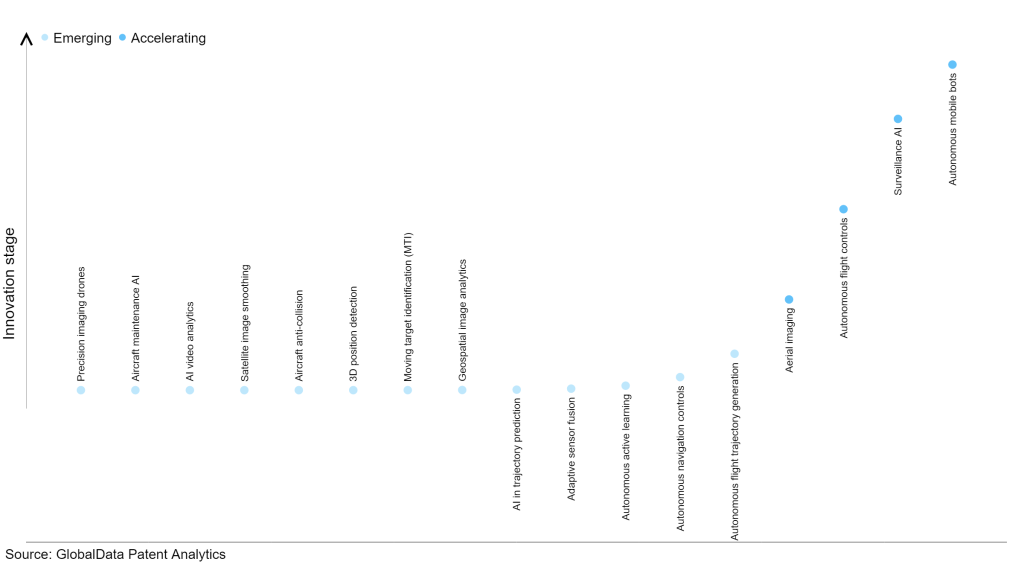The aerospace and defense industry continues to be a hotbed of patent innovation. Activity is driven by developments in artificial intelligence (AI) and machine learning, and the growing importance of technologies such as drones, satellite technology, and big data. In the last three years alone, there have been over 237,000 patents filed and granted in the aerospace and defense industry, according to GlobalData’s report on Artificial intelligence in defense: aircraft anti-collision. Buy the report here.
However, not all innovations are equal and nor do they follow a constant upward trend. Instead, their evolution takes the form of an S-shaped curve that reflects their typical lifecycle from early emergence to accelerating adoption, before finally stabilizing and reaching maturity.
Identifying where a particular innovation is on this journey, especially those that are in the emerging and accelerating stages, is essential for understanding their current level of adoption and the likely future trajectory and impact they will have.
110 innovations will shape the aerospace and defense industry
According to GlobalData’s Technology Foresights, which plots the S-curve for the aerospace and defense industry using innovation intensity models built on over 206,000 patents, there are 110 innovation areas that will shape the future of the industry.
Within the emerging innovation stage, precision imaging drones, aircraft maintenance AI, and AI video analytics are disruptive technologies that are in the early stages of application and should be tracked closely. Aerial imaging, autonomous flight controls, and surveillance AI are some of the accelerating innovation areas, where adoption has been steadily.
Innovation S-curve for artificial intelligence in the aerospace and defense industry

Aircraft anti-collision is a key innovation area in artificial intelligence
Aircraft anti-collision systems refer to technologies and methods designed to prevent collisions between aircraft and other objects or obstacles. These systems utilize various sensors, data processing modules, and algorithms to detect and assess the proximity of objects, calculate potential collision risks, and generate avoidance maneuvers. The systems aim to ensure the safety of flights by providing real-time information on the presence and location of obstacles and enabling the aircraft to navigate and maneuver accordingly.
GlobalData’s analysis also uncovers the companies at the forefront of each innovation area and assesses the potential reach and impact of their patenting activity across different applications and geographies. According to GlobalData, there are 30+ companies, spanning technology vendors, established aerospace and defense companies, and up-and-coming start-ups engaged in the development and application of aircraft anti-collision.
Key players in aircraft anti-collision – a disruptive innovation in the aerospace and defense industry
‘Application diversity’ measures the number of applications identified for each patent. It broadly splits companies into either ‘niche’ or ‘diversified’ innovators.
‘Geographic reach’ refers to the number of countries each patent is registered in. It reflects the breadth of geographic application intended, ranging from ‘global’ to ‘local’.
Patent volumes related to aircraft anti-collision
| Company | Total patents (2021 - 2023) | Premium intelligence on the world's largest companies |
| Huawei Investment & Holding | 5 | Unlock Company Profile |
| Thales | 6 | Unlock Company Profile |
| Israel Aerospace Industries | 9 | Unlock Company Profile |
| Eidgenossische Technische Hochschule Zurich | 4 | Unlock Company Profile |
| Saab | 11 | Unlock Company Profile |
| Intertrade | 4 | Unlock Company Profile |
| General Electric | 4 | Unlock Company Profile |
| Amazon.com | 17 | Unlock Company Profile |
| Nippon Telegraph and Telephone | 11 | Unlock Company Profile |
| BT Group | 4 | Unlock Company Profile |
| NEC | 5 | Unlock Company Profile |
| Intel | 8 | Unlock Company Profile |
| SPACE DATA | 8 | Unlock Company Profile |
| Everseen | 5 | Unlock Company Profile |
| Samsung Group | 6 | Unlock Company Profile |
| Ariel Scientific Innovations | 6 | Unlock Company Profile |
| Seamatica Aerospace | 5 | Unlock Company Profile |
| PABLO AIR | 6 | Unlock Company Profile |
Source: GlobalData Patent Analytics
Boeing is one of the leading patent filers in aircraft anti-collision. The company filed patents for methods and systems of midair collision avoidance, ground maneuvering and collision avoidance during aircraft surface operations, automatic aircraft traffic separation and conflict avoidance, and collision sense and avoidance system for unmanned aerial vehicles (UAVs) and remotely piloted vehicles (RPVs), among others.
It tested a new low-profile light-emitting diode (LED) anti-collision light system as part of its ecoDemonstrator program in partnership with Alaska Airlines in 2021. Designed to fit mostly within the fuselage, the anti-collision light system reduces drag to improve fuel efficiency, while providing 360° visibility and offering better light protection.
Some other key patent filers in the aircraft anti-collision space include General Dynamics, Airbus, and Saab.
In terms of application diversity, Skydio, Thales, and Intertrade are some of the leading patent filers. By means of geographic reach, some of the leading patent filers include General Dynamics, Israel Aerospace Industries, and Thales.
To further understand the key themes and technologies disrupting the aerospace and defense industry, access GlobalData’s latest thematic research report on Artificial Intelligence (AI) in Defense.
Data Insights
From

The gold standard of business intelligence.
Blending expert knowledge with cutting-edge technology, GlobalData’s unrivalled proprietary data will enable you to decode what’s happening in your market. You can make better informed decisions and gain a future-proof advantage over your competitors.







